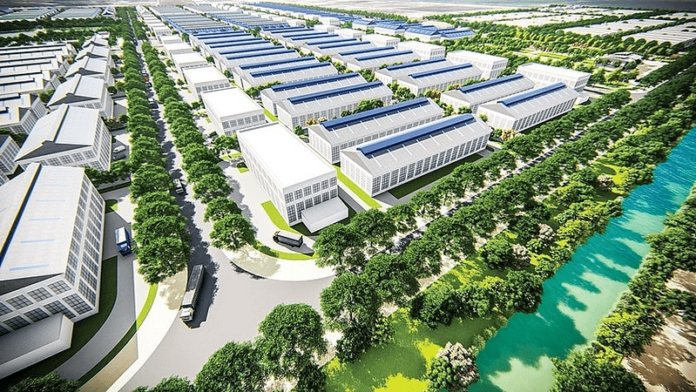Eco-industrial parks (Eco IP) play a crucial role in attracting investment and enhancing competitiveness, yet they still lack the necessary legal framework for development.
DEEP C IP (Hai Phong) has so far been able to self-supply over 1% of its annual electricity consumption through renewable energy with one wind turbine and two rooftop solar power projects. It aims to increase this figure to 30% by 2030. Ms. Nguyen Nhu Thanh Thu, Head of Renewable Energy Department at DEEP C IP, said that investing in renewable energy is not a highly profitable project but DEEP C is still determined to implement it to meet the needs of secondary investors, including foreign-invested enterprises and domestic private enterprises.
This is also seen as a strength to attract investment for DEEP C, in the context where businesses and investors are seeking opportunities to access services that serve ESG practices (environmental, social, and governance). With that mindset, in addition to building renewable energy projects, DEEP C also applies many unique solutions, including an organic farm to provide food for low-income workers or the DEEP C Care project to support local people. That is the difference that creates a competitive advantage, according to Mr. Bruno Jaspaert, CEO of DEEP C. “We never compete on price and investors who come to us don’t negotiate lower prices. They come because we are ‘greener’, meeting the needs that investors are looking for,” affirmed the CEO of DEEP C.
Sharing the same view on competitive advantages in the new context, Nam Cau Kien IP (Hai Phong) is developing a symbiotic industrial model towards a circular economy. Mr. Pham Hong Diep, Chairman of Shinec JSC, the investor of Nam Cau Kien IP, said that three symbiotic industrial models in the metallurgy – mechanics, plastics, and electrical auxiliary industries are being implemented in this IP.
These three models are enthusiastically participated in by enterprises operating in Nam Cau Kien IP due to achieving practical benefits. For example, a steel production unit that used to spend 5 million VND for each ton of steel slag can now sell a unit producing magnetic steel and separating metal impurities for 5 million VND. Along with that is a centralized wastewater treatment area designed as a “Japanese garden” to receive and welcome visitors.
Looking at the 2.3MW wind turbine, Mr. Bruno said that it took three years to obtain a construction permit because Vietnam has not yet issued technical standards for installing wind power in IPs. “We have a sustainable initiative but getting permission from the state management agency to implement it is not simple,” said Mr. Bruno. Another challenge for DEEP C is the reuse of wastewater. Owning a centralized wastewater treatment line with output water quality even better than raw water, but enterprises in this IP cannot put it into remanufacturing, or even cannot be used for irrigation, because there are no regulations allowing this.
In an interview with the press, Mr. Diep also agreed that the incomplete legal framework is the biggest difficulty in building eco-IPs. According to Mr. Diep, some legal regulations are not synchronized and still create many barriers for enterprises to apply solutions. For example, Nam Cau Kien IP wants to build a centralized waste treatment area for operating enterprises, but according to the previously approved planning, the waste treatment area must be built in another area. Along with that is the lack of incentives for enterprises operating in eco-IPs.
This is a big barrier because to successfully build an eco-industrial park, it not only depends on the investor’s will but also needs the concerted efforts of secondary investors. Currently, the Ministry of Planning and Investment is proposing to build a Law on Industrial Parks and Economic Zones. Mr. Diep hopes that the new law will add more incentives, solve the unsynchronized regulations, and become a sufficiently solid legal basis for enterprises and investors to boldly develop eco-industrial parks.




